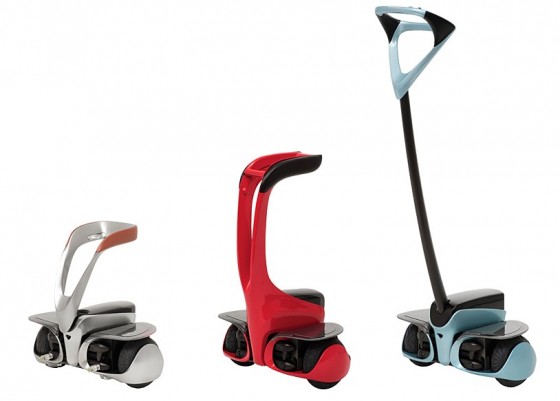Toyota says it’s newest invention, the Winglet, is a personal assistant robot but their move rather resembles an open attack at Segway. The vehicle the world’s biggest manufacturer of automobiles presented today will feature an electric motor, two wheels and a set of sensors to ensure stability.
Just like its American counterpart, the Winglet (odd name) is ridden in a standing position. You will be able to move forward or backward or take turns by shifting your body weight. Three versions will be available: S (1.5 feet tall), M (2.2 feet) and L (3.7-feet). The S-Model weighs 9.9kg, while the M and L versions will be a little heavier at 12.3kg.
A full charge takes just one hour, enough for a driving range of 5km for the mini-Winglet and 10km for the bigger models. The maximum cruising speed is 6km for all Winglet versions.
Segway doesn’t have much time to react to Toyota’s new vehicle. The Japanese mega-company scheduled the start of production at 2010. Consumer testing will begin as early as this fall, in a marine resort complex in Aichi prefecture (central Japan) and at Nagoya airport. Prices and availability are unknown at this point.
Full press release in English after the jump.
Toyota Develops Personal Transport Assistance Robot ‘Winglet’
Aug 1, 2008 Tokyo — TOYOTA MOTOR CORPORATION (TMC) announced today development of the “Winglet”, a personal transport assistance robot ridden in a standing position.
The Winglet—still being refined—is one of TMC’s people-assisting Toyota Partner Robots. Designed to contribute to society by helping people enjoy a safe and fully mobile life, the Winglet is a compact next-generation everyday transport tool that offers advanced ease of use and expands the user’s range of mobility.
The Winglet consists of a body (with a projected area the size of an A3 sheet of paper) that houses an electric motor, two wheels and internal sensors that constantly monitor the user’s position and make adjustments in power to ensure stability. Meanwhile, a unique parallel link mechanism allows the rider to go forward, backward and turn simply by shifting body weight, making the vehicle safe and useful even in tight spaces or crowded environments.
TMC has created three models, the “L”, “M” and “S”, each having different handling features that allow consumers to select a model appropriate to their needs—from “practical” to “hands-free sporty”.
TMC plans various technical and consumer trials to gain feedback during the Winglet’s lead-up to practical use. Practical tests of its utility as a mobility tool are planned to begin in Autumn 2008 at Central Japan International Airport (Centrair) near Nagoya, and Laguna Gamagori, a seaside marine resort complex in Aichi Prefecture. Testing of its usefulness in crowded and other conditions, and how non-users react to the device, is to be carried out in 2009 at the Tressa Yokohama shopping complex in Yokohama City.
TMC is pursuing sustainability in research and development, manufacturing and social contribution as part of its concept to realize “sustainability in three areas” and to help contribute to the health and comfort of future society. Toyota Partner Robot development is being carried out with this in mind and applies TMC’s approach to monozukuri (“making things”), which includes its mobility, production and other technologies. In a related development, TMC unveiled the “MOBIRO” mobility robot, designed for use in a sitting position, in 2007.
TMC aims to realize the practical use of Toyota Partner Robots in the early 2010s by furthering its robotic development and strengthening collaboration between industry, government and academia.
